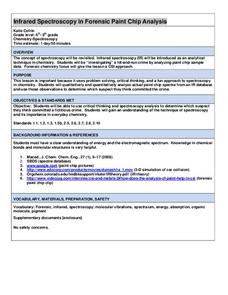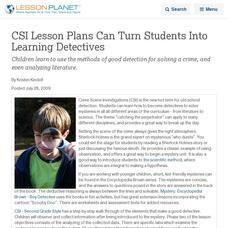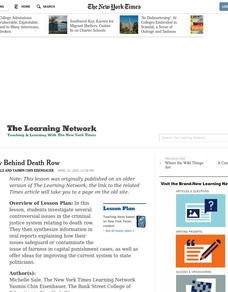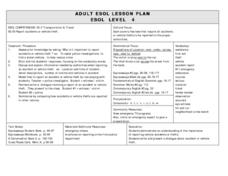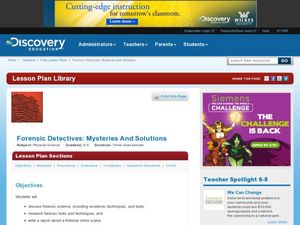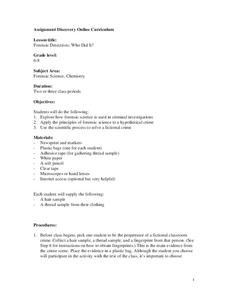Curated OER
Who Ate The Cheese?!
In this crime scene investigation worksheet, students simulate DNA sequencing and DNA restriction analysis using paper strips of DNA. Students compare the crime scene DNA to the suspects and determine who is guilty.
Curated OER
Infrared Spectroscopy in Forensic Chip Analysis
Students analyze spectrums as related to forensics. In this chemistry lesson, students define spectroscopy and discuss its use in chemistry. They discuss how the Forensic Paint Chip is used to help solve crimes.
Curated OER
DNA Fingerprinting
Students discuss DNA Fingerprinting and gel electrophoresis before participating in a crime solving activity. Students simulate their DNA using adding tape and complete the steps necessary to do a gel electrophoresis. They discuss the...
Curated OER
CSI Lesson Plans Can Turn Students Into Learning Detectives
Children learn to use the methods of good detection for solving a crime, and even analyzing literature.
Curated OER
Meting Out Justice
Students investigate the murder case of Emmett Till and identify the missing pieces from the case. Through research, they then work to fill in the gaps to create a basis for examining how justice might be served anew in this...
Curated OER
Covering the News
Students compare the coverage of two crime stories Using local or national newspapers, news magazines and other reference materials, each group trace the "unfolding" of two crime stories: The Laci Peterson investigation plus one students
Curated OER
The Row Behind Death Row
Students investigate several controversial issues in the criminal justice system relating to death row and give oral reports explaining how their issues safeguard or contaminate the issue of fairness in capital punishment. They offer...
National First Ladies' Library
Safety or Civil Liberty? The Trial of Sacco and Vanzet
Students investigate the Sacco-Vanzetti trial and develop a basic understanding of the issues involved. Then they write an essay taking a stance on the Sacco-Vanzetti trial: was the trial fair? were the two men falsely accused? Finally,...
Curated OER
NUMB3RS Activity: Regular Ploygon Centroids
Students investigate geo-profiling. In this secondary mathematics activity, students use geo-profiling to determine the most probable location of a criminal. Students find the centroid of a polygon where the vertices represent crime...
Curated OER
Juvenile Offenders
Students investigate how different democracies treat juvenile offenders as well as compare/contrast the juvenile and adult justice systems in their own democracy. In addition, individually and as a group, they determine whether juvenile...
Facing History and Ourselves
Continuing Lemkin's Legacy: What Can We Do to Prevent and Stop Genocide?
Young scholars investigate genocide. In this contemporary history instructional activity, high schoolers research Darfur advocacy organizations and present plans of action to stop the injustice in Darfur.
Curated OER
Hair Test
In this forensic science worksheet, students answer 3 open response questions about hair evidence collected from the crime scene.
Curated OER
Identifying Bullies
Young scholars investigate human behavior by defining bullies. In this psychology lesson, students read the book Just One Flick of a Finger, and discuss why bullies act out in front of other children. Young scholars investigate actions...
Curated OER
Pressing Cases
Students investigate famous criminal cases in which the media has played a significant role and reflect on how the news helps to shape attitudes and behaviors in their own lives.
Curated OER
Freedom of Hate Speech?
Students, using a New York Times article as a springboard for discussion, investigate and debate the complex issues of First Amendments Rights and censorship for Hate Groups using Websites for propaganda.
Curated OER
Civics: Juvenile Justice in Missouri
Students investigate their rights and responsibilities as juveniles in the Missouri legal system. After taking a poll on juvenile justice, they discuss their responses and suggest changes which they could send to the state legislature. ...
National First Ladies' Library
Impeachment!
Young scholars investigate the impeachment proceedings against Andrew Johnson, Richard Nixon, and William Clinton. In small groups they conduct Internet research on one of the three Presidents, and present a "brief" on the case,...
Curated OER
Flipping Coins: Density as a Characteristic Property
Young scholars explore linear functions in a crime solving context. They collect and analyze data using linear equations, then interpret the slope and intercepts from a linear model.
Curated OER
What Events Led to Lincoln's Assassination?
Fourth graders investigate the assassination of Abraham Lincoln. In this American history lesson plan, 4th graders conduct research, share their findings, and write a report about the events leading up to the death of President...
Scouts
The Deadly Picnic: A Lab on Deductive Reasoning
Whodunnit? Find out who killed Mr. Brooks through a logical examination of evidence. Class members fill out a couple of data tables to help them pin down the suspect. After they've figured out just who the culprit is, pupils compose...
Curated OER
A Crime Against Plants
Students research the phenomenon that is living in a small tree. They develop their own conclusion on what they believed is occuring. They answer discussion questions to end the instructional activity.
Curated OER
Reporting Crime To Authorities
Students review how laws protect people from harm and loss of property. Students discuss and explain the infromation needed when making a report to authorities about a theft or bodily harm. A dialog is created and role played. This...
Curated OER
Forensic Detectives: Mysteries and Solutions
Students examine forensic science. In this video based instructional activity, students examine the tools and techniques of forensic science. They write a report about a fictional crime scene from the Discovery video.
Curated OER
Forensic Detectives: Who Did It?
Middle schoolers explore forensic science and its uses in criminal investigations. They solve a fictional crime by identifying and analyzing the fingerprints, strand of hair, and thread samples for evidence. After completing charts for...



